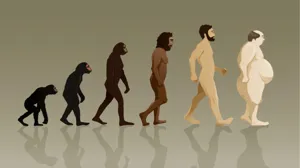
The Paleo Diet
The Paleo Diet has been inspired by the study of our own human history. The Paleolithic Period began about 2.6 million years ago with the first use of stone tools by pre-historic humans and ended about 10,000 years ago. In the Paleolithic Period, humans formed small groups and survived by hunting and gathering food. The end of the Paleolithic Period is marked by human groups settling in one era, introducing agriculture, religion and culture that has survived to the current day. Humans clearly evolved during the long Paleolithic period, developing physically and genetically. The successful survivors of that era thrived because they were eating and living in a way highly compatible with their genetic structure. It is possible our genes have evolved to some degree over the more recent 10,000 years, but it is most likely that this change is small.
The Paleolithic Period was not entirely uniform: hunter-gatherer tribes varied in their use of fire or their ability to fish for food. Surprisingly, a great deal of evidence indicates that the hunter-gatherers, dependent on the whims of nature for their food, were actually healthier in many ways than the early farming communities that developed later. Controversies exist concerning what Paleolithic people actually ate, leading to some differences among adherents of the Paleo Diet.
Essentials of the Paleo Diet are well agreed upon, as well as the belief and observation that following such a diet, particularly in the setting of a Paleo Lifestyle enables one to prevent and even reverse many of the diseases associated with life in the modern world.
Paleo Diet
Protein comes from grass-fed meat (beef, lamb, wild game); free-ranging pork and chicken; fish, shellfish, eggs, and nuts. Organ meats from properly raised animals are particularly valuable. Nut butters from tree nuts are allowed.
Vegetables and fruits are allowed, optimally eating all the natural colors every one to three days.
Starchy vegetables (potatoes, sweet potatoes, yams, taro) are advisable in some minds, allowed by others, and generally forbidden by many. Somewhere between no starchy vegetables and 1-2 small servings daily.
Fats allowed include coconut oil, palm and palm kernel oil, lard, butter, and olive oil.
Dairy is negotiable: either none, or just butter, or just fermented dairy, or reasonable amounts of raw dairy, not meant to replace meat sources of protein.
The Paleo Diet consistently excludes
- All grains
- All legumes
- All vegetable oils
- All added refined sugars
Now here’s the trick: where The Paleo Diet gets downright personal. How do you feel after six weeks following this diet? Has your psoriasis cleared up? Your fibromyalgia eased up? Terrific! Or are your migraines still plaguing you? Your eczema no better?
If you’re BETTER, you get to think about slowly and gradually re-introducing missed foods, one by one, at least three days per food. I would suggest saving gluten-containing foods to last or never, it’s the most problematic category for digestive health and anything affected by digestive health…uh, which is pretty much everything.
If you’re NOT BETTER, consider the next six weeks restricting further to the Autoimmune Paleo Protocol, which will eliminate eggs, nuts, nightshades and some other frequently problematic food groups. This is an excellent diet created and described by Sarah Ballantyne. My ONE area of disagreement with her is that I would eliminate shellfish: densely nutritious as they are, they are also a source of potential food allergies. So, sorry, no shrimp for now.
Paleo Lifestyle
Contrary to what one might think, our Paleolithic ancestors lived a remarkably relaxed life, with little episodes of absolute urgency – either to catch dinner or to avoid being dinner. They worked an average of 5-10 hours a week to obtain food and maintain their lives. They spent a great deal of time relaxing, socializing with family and friends, and resting.
Their lifespan was of course compromised by the primitive conditions. Mortality occurred in childbirth and from trauma. Infectious diseases took their toll generally in childhood, and generally before the age of 30. Paleolithic people surviving to 30-40 years of age generally had the same life expectancy we do now, with one stunning exception: they remained vital, free of evidence of chronic disease, until they died. If this information is confounding to grasp, I refer you to Dr. Loren Cordain’s excellent paper on the subject.
We, too, can make lifestyle choices that can increase the likelihood that we remain healthy late in our lives.
- Exercise. A wise exercise program is not difficult to incorporate into a modern lifestyle.
- On a daily basis: walk around, stand up from your desk, park farther from the store, use the stairs often and the elevator rarely. Sit on the floor and get back up again, at least a couple times a day. See if you can walk up and down stairs with good posture and – if you can do it safely – without holding on to the rail.
- A couple times a week do something fast and challenging. Run up a flight of stairs and walk down, ten times. Do some high intensity interval exercise or go to a challenging workout class: Zumba, Oula, or a spinning class.
- Incorporate some heavy lifting, with good body mechanics, either as intentional weight lifting, or just gradually lifting two bags of groceries instead of one, or a taller pile of books as you head to a different part of the house.
- Sleep. Easier said than done: get a good night’s sleep on a regular basis! Although hunter-gatherers probably slept communally, and took the opportunity to nap during the day, few of us can or would choose a similar routine. Consistent, adequate, and un-medicated sleep can be best assured by the following guidelines.
- Sleep in a dark and quiet room, more on the cool side than the warm side (68 degrees or less). No electronic gadgets in the bedroom.
- Rise with the sun!
- Exercise daily, either in the morning or certainly before dinner.
- Spend some time outside each day.
- Eat at least an hour before going to bed. No alcohol after dinner.
- Dim the lights around you when the sun goes down, and avoid “screen time” in the last hour before bed.
From Dr. Deborah’s Desk
I was fortunate to attend the Paleo FX Conference in Austin, Texas, in March of 2013. Enthusiastic would be an understatement to describe the predominant and infectious attitude shared among the audience and the speakers. I found myself among a full range of ages (although predominantly 20-40 years old I would say), body types, academic backgrounds, and levels of fitness. Folks were eager to learn more!To pick just two salient moments:
I watched a young man gently upend himself to a handstand. Walking on his hands (on cement), he gracefully walked up a flight of stairs, turned around and walked back down. He let his feet down to the ground as if it were an option not a necessity.
Secondly, Dr. Terry Wahls described not only her own experience reversing her progressive multiple sclerosis, but the clinical trials she has initiated evaluating the effects of the dietary changes on patients. It is too soon to know the results of the trials, but she was not alone in describing the potential for a Paleo Lifestyle to reverse quite serious disease.
I like what Robb Wolf, one of the most dynamic, irreverent and charming spokesmen for the Paleo Lifestyle, suggests: Try the diet, just the diet, for just 30 days. See how you feel.
Trying the Paleo Diet is safer than starting many prescriptions that might be offered for whatever ails you: you have everything to gain and nothing to lose.

